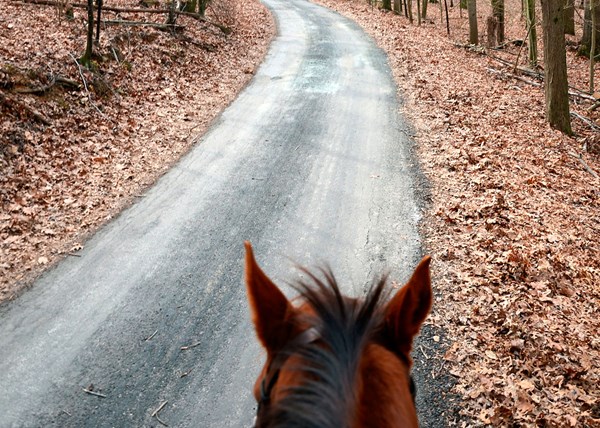 Credit: © STACEY NEDROW-WIGMORE When riding alone, always let someone know where you’re going and when you expect to return.
Credit: © STACEY NEDROW-WIGMORE When riding alone, always let someone know where you’re going and when you expect to return.There’s no better time to bond with your horse than when you’re alone together out on the trail. The lingering days of decent riding weather can provide the perfect opportunity for the two of you to get away from the routine of the arena and explore the territory beyond the barn. Whatever your intention—even if you’re heading out for just a short time and don’t plan to ride far—take steps before you depart to ensure your safe return. Riding alone can be dangerous. Accidents happen, and it’s best not to leave it up to chance that you’ll easily be found if you become separated from your horse. Here are some recommendations for riding solo safely compiled from the Facebook comments of Practical Horseman readers:
6 Tips to Ride Safer
-Always let someone know where you’re going—detail your route—and when you expect to return.
– Wear your helmet. You can’t do anything to help yourself get out of trouble if you’re knocked unconscious.
– Have your fully charged cellphone on your person. Resist the urge to tuck the device into a saddlebag so that your horse is carrying it. As one reader put it, “Ol’Dobbin isn’t going to phone home” if the two of you become separated.
– Carry identification on your person: your driver’s license, a USEF medical card or perhaps a Road ID bracelet or dog tag. Add your phone number to your horse’s saddle pad or saddle so there’s a way for him to be identified if he’s found without you.
– Add ICE—a contact number In Case of Emergency—to the directory on your phone. Many emergency workers will check specifically for “ICE,” so use the abbreviation to aid their efforts.
– Consider carrying a SPOT Satellite GPS Messenger or similar device, which allows communication with family, friends and emergency medical services personnel even in areas where you don’t have a cell signal.
5 Places to Stash Your Phone
Where’s the best place to stow your cell phone and ID when you’re riding? Readers offer these suggestions:
– A holder made specifically for your cellphone or other small personal items that is or attaches to a belt, armband or leg band. Two popular products include the iFitness belt and SPIbelt. In some cases, it’s also possible to attach the holder to your half chaps or a boot.
– Riding pants with a pocket designed to hold a cellphone: the Devon-Aire X-Wear Sensation Cell Phone Riding Tight, Irideon Issential Cargo Breech and Kerrits Power Stretch Pocket Tight are a few examples. The back pockets on Dover Riding Sport Jean Breeches are set slightly to the side to hold a phone comfortably while you’re in the saddle. Riders with some sewing ability may want to take matters into their own hands and stitch pockets onto their breeches.
– A lanyard with an attachment to accommodate your cellphone. To keep the device from bouncing against your chest as you ride, tuck it beneath a shirt or jacket.
– A vest with pockets. A number of companies make suitable models. Even a lightweight mesh fishing vest can fill the bill.
– A fanny pack (often regarded as not fashionable, but extremely useful).
Wherever you decide to carry your phone, bear in mind one reader’s caution: “While trail riding, I had my small digital camera in my back pocket when I fell off my horse. My helmet cracked and I had a huge back bruise from that camera. I couldn’t walk for almost two weeks. Put nothing on your back,” is her advice.
This article originally appeared in the August 2013 issue of Practical Horseman.






